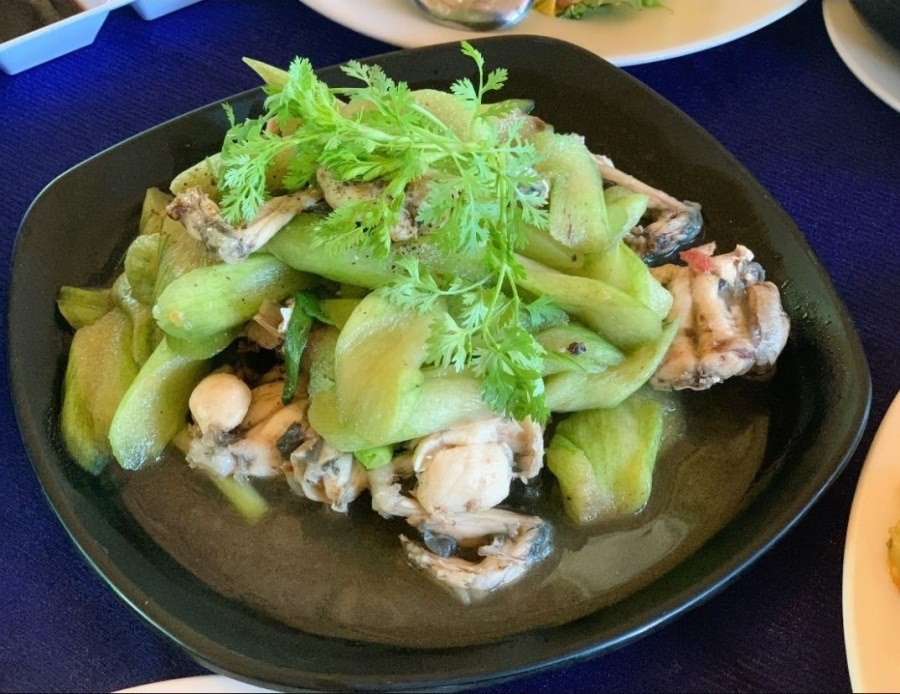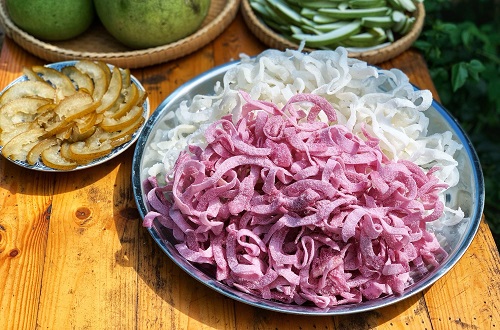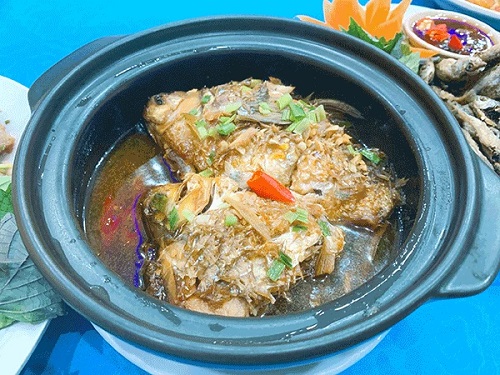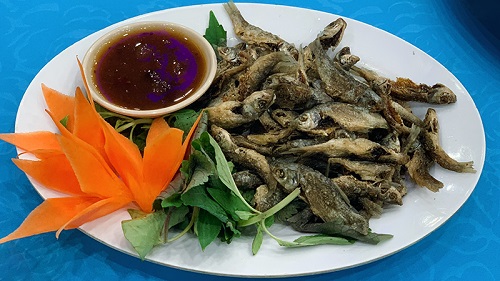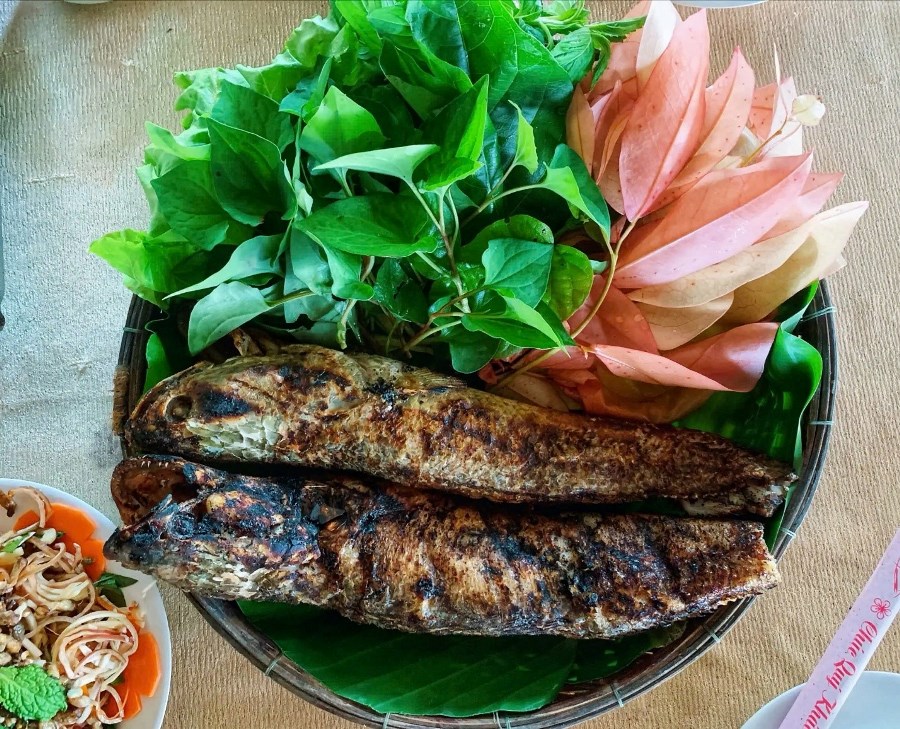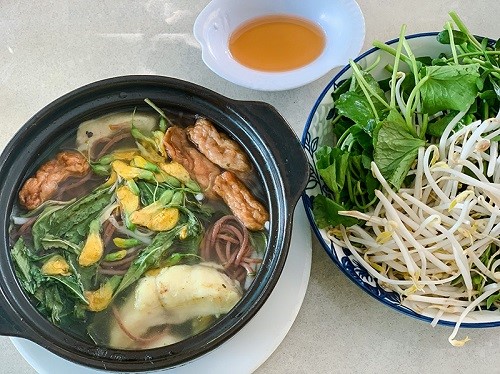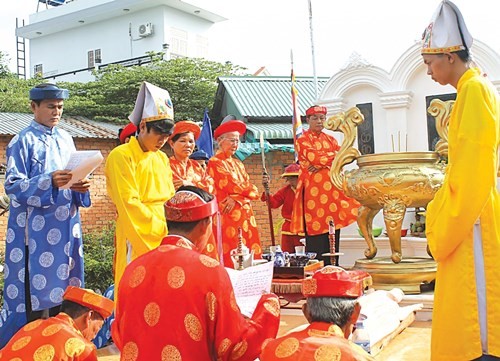
Local people usually avoid the word “the Pig” in communal house rituals by using different names based on how it is offered: “cang lạp” refers to the sacrifice to Thần Hoàng Bổn Cảnh (Village God); a piglet is named “đột phì”; “heo cơm” is the sacrifice to Tiền hiền (land reclaimers) - Hậu hiền (nation-builders) ”; “con gỏi” is the so-called roast pork and “cẩm địa” is offered the descendants of “Tiền hiền”. Apart from old terms of “cang lạp” and “đột phì”, the others can be interpreted as follows:
- “Heo cơm”: On Kỳ Yên Festival, village representatives worship “Tiền hiền - Hậu hiền.” “Tiền hiền” are those who reclaimed the land where the communal house is located. “Hậu hiền” are those who created and developed the village by opening markets, building, maintaining roads, etc. Therefore, there is a saying that " Tiền hiền khai khẩn - Hậu hiền khai cơ” (Tiền hiền reclaimed and Hậu hiền established the village.) The sacrifice to Tiền hiền and Hậu hiền is called “heo cơm”. After performing the ritual, people will butcher it to treat worshipers, festival servers, “bội” performers, and other participants.
- “Con gỏi” is offered to Gods by locals with gratitude. There is a knife on the pig’s back, implying that Gods can help themselves to the sacrifice.
- “Cẩm địa”: As mentioned, there are always two altars in Southern communal houses to worship Tiền hiền and Hậu hiền. Their descendants are highly respected and served as top guests in communal house rituals. The pork shoulder sacrificed to Gods is always the best. It is also dyed red (cẩm địa) to offer the descendants of “Tiền hiền”. This explains why it is called " Tiền hiền cẩm địa” in some localities. In some cases, the term "Cẩm địa” is written on the altar instead of "Tiền hiền".
According to the ancient custom, the sacrifice was said to be a pitch-black pig. It was forbidden to offer a white pig because the color white symbolized grief. However, as time went by, this conception has changed. These days, a pure white pig is the first choice. Regarding these customs, "Hương đảng thường nghi trích yếu” by Đinh Công Chánh, a figure with meritorious services of Bình Thủy Communal House (Bình Thủy District, Cần Thơ City) clearly states, “The Xia Dynasty preferred the color black, so they buried the dead in the middle of the night. In wartime, they rode dark horses; therefore, they sacrificed black animals. The Yin Dynasty, however, liked the color white, so deaths were buried at noon. Soldiers rode white horses. Accordingly, the sacrifice was white animals. Likewise, red was favored by the Zhou Dynasty …” Obviously, Đinh Tôn Thần well concluded that the color of the sacrifice was based on the concept of "other times, other manners". However, never have people chosen pigs with spots.
In addition, the sacrifice must be virgin, alive, and kicking. In the past, village representatives demanded purebred pigs, yet this is difficult in this day. In olden times, 3-4 months before the official day, the representatives prepared 3-4 pigs. On the ritual day, people would resort to sortilege to pick one. But nowadays, the selection of pigs is no longer so complicated. They pick the sacrifice only when the ritual is around the corner. These are distilled into the old saying,
“Trông mặt mà bắt hình dong, (Judge the book by its cover,)
Con lợn có béo bộ lòng mới ngon.” (The heavy pig is of top quality.)
The significance of the sacrifice in communal house rituals is clearly demonstrated by Tỉnh Sanh Ritual. This ritual is normally performed at midnight. The representatives will pour alcohol all over the pig and in its mouth which implies the sacrifice is clean and healthy. Before the pig is butchered, the organizers will respectfully present a bunch of its furs and some blood to Gods meaning it is in good health and worthy of sacrifice. This ritual is solemnly and respectfully made by a range of ritual performers.
In the research process, it was fortunate for us to read a Roneo-printed book of " Đình Thần Long Tuyền " written by Nguyễn Tứ Di, a senior in the ancient village of Long Tuyền, in 1973. In this precious document, he narrated how pigs had been purchased and “Lục ấp” (six hamlets of Long Tuyền Village) had performed Bình Thủy communal house rituals. Accordingly, all six hamlets ought to offer a pig every communal house ritual.
According to Nguyễn Tứ Di, Tỉnh Sanh Ritual, or so-called Trình Sanh Ritual in Bình Thủy Communal House was methodically performed. The village representatives in black ao dai held a tray of betel and alcohol. Four other people carried and left the sacrifice in front of Túc Nghi Communal House. After that, they entered Túc Nghi Communal House, placed the tray, burned three incense sticks, poured alcohol, and stood upright to worship, “May God be my witness, I’m sacrificing a heavy pitch-black pig to God of Agriculture this morning.” In the end, they marked the pig head with red powder to indicate that it was chosen. The author also noted that pigs offered at the God of Agriculture Ritual should be alive, not boiled or roast. Live pigs were believed to be full of vitality.
Speaking of “thủ vĩ”, it is the offering of the pig head. This is explained that although some worshipers desired to offer a whole pig, they could not afford the sacrifice. Thus, folks "simplified" the custom by offering the head instead of the entire pig. They believe that Gods bless them and do not reject them. Regarding the set of “thủ vĩ” offering, it includes a pig head, a tail, four hocks, and internal organs, which represents the whole pig. They will be boiled afterward. The pig head will be particularly covered with caul fat - membranous fat surrounding the stomach of the pig.
Like the worship of the Gods, “thủ vĩ” offering is part of the spiritual life of Southern people for generations. When Southern people pray to Gods such as God of Wealth, Earth God, Bà Chúa Xứ, they all promise to offer pig heads if things turn out smoothly and perfectly.
* * *
The Chinese zodiac sign of the Pig symbolizes prosperity, joy, happiness, and leisure. The Pig represents the concept of good and blissful reproduction. Additionally, it has become an important part of the religious culture of Southern people for generations.
As the Year of the Pig has come, let’s wish one another prosperity and happiness!
................
References:
(4) Huỳnh Ngọc Trảng - Trương Ngọc Tường - Hồ Tường. (1993) Văn hóa dân gian cổ truyền Đình Nam bộ, tín ngưỡng và nghi lễ. Ho Chi Minh City Publishing House.
- Documents saved in Cần Thơ Communal houses
Source: Can Tho News - Translated by Diep Truong







